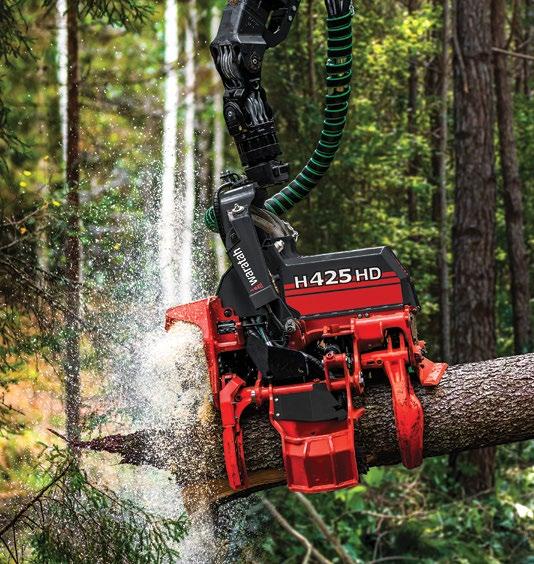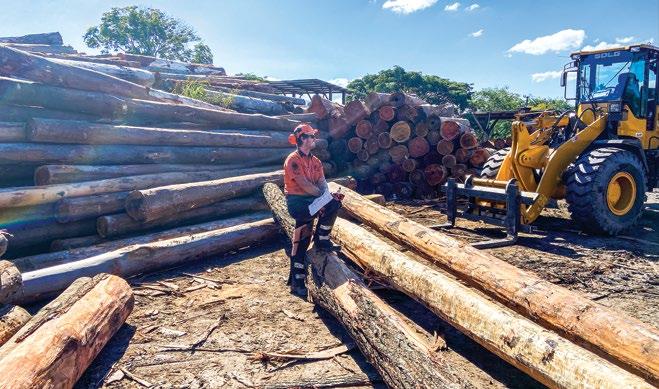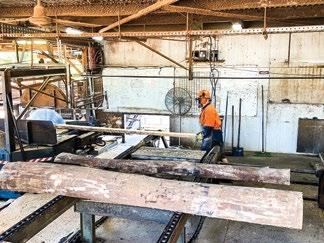
13 minute read
Mills
BRIEFS
Air tanker shared
THE Victorian and Queensland Governments have secured a deal to share a Large Air Tanker to support aerial firefighting capacity in both states during their respective bushfire seasons.
The Bombardier Dash-8 Q400AT aircraft will operate in Queensland from September to December to cover their bushfire season and will operate in Victoria for the height of summer from December to February.
Sharing aerial firefighting resources provides both states with better value for money while ensuring the aircraft is available to support firefighting efforts on the ground when and where it is needed most.
The agreement covers the 2021 to 2024 bushfire seasons and the Large Air Tanker will remain in Victoria between bushfire seasons.
George goes harvesting
GEORGE the Farmer has traded his tractor for a harvester in an effort to teach Australia’s next generation about the importance of plantation forestry.
The highly acclaimed children’s character joined key industry leaders in the Green Triangle to film the new six-minute video illustrating everything from tree planting and harvesting to the milling process, showcasing the wealth of products created by our local fibre.
The forestry video, which will air on the ABC, has been produced as part of the Federally-funded $5 million ‘Educating Kids About Agriculture’ project, in collaboration with Primary Producers SA and Australian Forest Products Association.
New radio system
A NEW digital radio system is helping New Zealand’s City Forests to work more safely and efficiently while complying with COVID-19 work requirements. Initially deployed to replace an outdated analogue radio network, the system from Motorola Solutions and communications partner Central Radio Services delivers many additional benefits.
Among them are contactfree communication and social distancing in the field, replacing the need for drivers to exchange paper job dockets with a digital docketing system.
Waratah Forestry Equipment unveils new harvester heads
Waratah Forestry Equipment announced the new H425, H425HD and H425X – a trio of rugged harvester heads built for tough jobs.
With a powerful control valve and four roller feed arm geometry, each high-performance head is productive on wheeled or tracked carriers.
“These models are built for durability and performance,” said Brent Fisher, product marketing manager for Waratah. “Among other updates, new hose protection and servicing enhancements make these great heads even better.”
The standard H425 (1360 kg or 2,998 lb.), H425HD (1390 kg or 3,064 lb.) and hefty H425X (1426 kg or 3,143 lb.) each offer increased reliability with new feed motor hosing routings and new covers. For quick and easy servicing, each head features a new hinged valve cover and improved access to greasing points. H425
Optimizing performance, productivity and delimbing, the H425 excels in large diameter regeneration harvesting. A powerful control valve and feed-roller arm geometry ensure a solid grip and agile harvester head control for all diameter classes.
For increased uptime and lower daily operating costs, the H425 offers improved hose routing from boom to harvester head and from the valve to feed motors, keeping hoses well protected from limbs and understory interference.
The H425 offers optional saw motor sizes, standard (narrow stem) or buttress (wide stem) saw frames for challenging applications, and processing knives for picking stems from the ground or bunch piles. H425HD
Built to work on the toughest jobs, the H425HD features a heavy-duty tilt frame, feed motors and guarding to provide even more durability. With a powerful control valve and a top saw option, the high-performance head offers great productivity, especially for wheeled carrier applications.
For ease of maintenance, the H425HD now has easy filling of saw chain oil. Likewise, daily maintenance can be performed without changing the position of the harvester head. The valve block and grease points are also easily accessible.
The H425HD offers optional saw motor sizes, standard (narrow stem) or buttress (wide stem) saw frames for challenging applications, and processing knives for picking stems from the ground or bunch piles. H425X
The H425X features an extreme duty main saw box with heavier steel plating, extra feed motor component guarding, heavy-duty tilt frame, hose protection and increased drive arm durability for demanding applications in mixed stand harvesting. Its four roller feed arm geometry ensures rollers grip solidly in all diameters, improving responsiveness with unprecedented tree-processing performance – especially in large timber.
Purpose-built for tracked harvesters, the H425X offers options for many applications with multi-tree handling, an integrated top saw and processing knives for picking from piles or hardwood applications, and many feed wheel options to suit numerous applications.
“The H425, H425HD and H425X are reliable heads for heavy-duty applications,” Fisher said. “With each new head generation, we’re providing our customers the solutions they need to maximize productivity and uptime.”
The Waratah H425, H425HD and H425X are currently available to customers in Europe, the United States, Canada, Australia, New Zealand, Russia, Africa, Asia, Brazil and Latin America.
Mill Profile Strategic skills needed for future
Philip Hopkins
Tom Hooper was a chess champion at school. As manager of Mary Valley Sawmill, his strategic skills are needed to plot a path forward through the forces buffeting his hardwood business.
These could be the weather, resource security, the economy, market trends and politics – not all issues that a strategic games player can control. “We are always mindful of the future of the resource. It’s a bit of unknown, particularly with timber from the Crown. We have four years to run on our licence, and they talk of an extension for two years, with a big review and possible reduced volume,” he said. “It’s an unknown, not a given.”
However, the family hardwood timber business, dating from the 1920s and located in the pretty Mary Valley at Dagun, near Gympie in south-east Queensland, is well prepared, having just opened a new processing mill.
Tom works with his fatherin-law, Wayne Morris, who came to Queensland from Warburton in Victoria 33 years ago. Compared to Victoria, what struck him was the lack of environmental ‘aggro’. “The fact we don’t clear fall – a huge issue – is an advantage,” he said.
Another big difference was the resource; in Queensland, about two-thirds of the wood comes from private landowners and one third from the Crown. Not at Mary Valley Sawmill, however; Tom estimated up to 60 per cent of the timber is Crown and 40 per cent private. “The Crown allocation is very important to this business and the markets we have created. We get 4150 cubic metres of compulsory wood, plus optional timber, depending on the quality of the bush. They are quality sawlogs,” he said. This total could end up at 6000-7000m3, including salvage and low-quality wood after fires.
Private wood comes from contracts with individual landowners. All up, the mill processes on average up to 12,000m3 annually.
Tom said traditionally, sawmills were given licences for the dominant species in those areas. “You build a market on the area available to you We are in line with our species - blackbutt, ironbark, forest red gum, grey gum, tallow wood. They’re the five main commercial species,” he said.
From the private sector, timber is predominantly spotted gum, although there is some ironbark and blue gum. “Ironbark is one of our main sought-after species, blackbutt also, for the markets we have built,” said Tom.
Green sawn products predominate, although there is some drying, with light commercial jobs a big market, such as government tenders for outdoor structures. The company’s durable hardwoods are ideal for outdoor products.
“We control our quality. Our high-end jobs include the Noosa boardwalk, the Sunshine Coast Plaza, Sunshine Coast University hospital, the big barracks in Townsville and Fraser Island boardwalks,” said Tom.
Mary Valley Sawmill has about half a dozen private suppliers. The properties vary in size, from 20,000 acres to 4000, 6000 and 2500 acres, and even small blocks – more than 30,000 acres in total.
Ensuring supply is crucial. “We convince all suppliers to log sustainably by cutting much lighter. It’s a selective logging process where a good-sized tree is left, but it will be big enough to harvest in 10 years,” said Wayne.
“You do the bush more damage if you do not thin out. You must take some bad with the good to improve silviculture and growth. You look for retention and cut for the future and enhance growth while you do that,” said Tom, adding: “The private sector will be important for the long-term future of our business.”
Farmers have been frightened of the vegetation management laws, as changes of government have led to some locking up forests and a ban on tree cutting. “If done properly, there is enough private and Crown wood in Queensland to keep us going forever. If they introduced law to stop farmers cutting, we are in the deep end,” said Wayne.
What infuriates Tom is the export of native hardwood. “It’s criminal what the Government is allowing. Opportunistic log contractors are selling the wood without permits, it’s going undetected,” he said. “Communities are doing the hard yards and are dependent on these industries.”
Engineered wood for construction is a new frontier in Australia, but less so in Queensland due to the density and weight of local hardwood “For a beam like that you would need a 50-tonne crane to lift it into place!” said Wayne.
Mary Valley sells to wholesalers and has its own timber merchant yard on the Sunshine Coast. About 20 per cent of product goes to Victoria - a B-Double every week; veneer logs are sold in Tasmania, while blackbutt veneer is popular in the high-end architecture sector in Brisbane. There are two businesses on the 18-acre site at Dagun – the sawmill and a retail outlet for builders.
The business directly employs 26 but uses contractors and other bush operators. “We have the oldest and newest mill in this area. We can keep both running, which allows a variation of products, but maybe the old won’t last the more we value-add,” said Wayne.
“We have put in a kiln. We need to look at what we can produce with a good drying process. The kiln has the space to expand. The future could include laminating. The main thing is -
‘Do the beautiful timber justice’.”

The main thing is - ‘Do the beautiful timber justice’.

Looking Back
VICFORESTS has recorded zero logging truck rollovers in the 2019/20 financial year.
The turnaround is a boost from 2007/08 when it recorded 19 truck rollovers.
VicForests has a fleet in excess of 100 trucks and the dynamic nature of each trailerload of timber means log truck rollovers pose a major risk to its business with the potential for catastrophic consequences for truck drivers and other road users.
“Safety is our first priority at VicForests and we are pleased that our targeted approach ensures the protection of our workers,” VicForests CEO Monique Dawson said. 2016

HVP PLANTATIONS (HVP) has adopted FOLS as its required standard for the recording of training and skills verification for high risk forestry activities.
FOLS is a national industryled program, managed by ForestWorks, and supports the professionalism and safety of industry through an online system of recording and verifying the currency of operator skills.
John Dodson, Human Resources Manager at HVP, said the decision to adopt FOLS aligned with HVP’s strong commitment to workplace health and safety.
“FOLS helps to ensure workers are adequately trained, competent and safe to undertake their work activities.
“HVP’s initial emphasis will be in harvesting but in time will review the application of FOLS for silviculture, road construction and haulage activities,” he said.
HEAT and energy produced from forest management residue could significantly benefit Tasmania, according to US biomass and forestry expert Dave Atkins who visited the State recently.
Atkins said Tasmania’s climate made it a good location for thermal energy production which could be achieved using wood pellets produced from Tasmania’s forestry industry by products.
He said forest management residues were substantial.
In eucalypt forests, prescribed burning for site preparation is required for regeneration.
Cypress stands tall in Gippsland
Keith Smiley
Logging and milling 30 metre lengths of 100-year-old Cypress Macrocarpa trees is more than business to Phil Maddocks, who describes a love affair with the gilded timber.
During school holidays, Phil is supporting his aspiring AFL-playing son in the Interleague of Gippsland. It was a win for all, just like the punt he took on a turnkey sawmilling operation near the Strzelecki ranges.
Maddocks Sawmill began in earnest when Phil’s dad made a bold switch from a career in cattle farming, to cutting cypress trees: “The Cypress Macrocarpa is an unattractive tree on the outside but beautiful inside,” says Phil. “The grain has so many different colours, and were used as a fence or wind break.” These slow growing trees offer so little shrinkage, they are easy to work with and versatile.
When Phil took over the family business 19 years ago, he would purchase the logs from logging companies for milling at his 140-acre farm which had formerly been a plantation. “We found more consistency by logging them ourselves,” said Phil. They milled onsite, later finding it better to cut the logs themselves, and use contractors to haul the logs to their property in Ranceby, halfway between Korumburra and Warragul in Victoria.
The logging trucks make about ninety runs a year, or $30,000 in total for transporting the logs, from catchments an hour away. Much of the surrounding district had wind rows of Cypress, planted earlier by Italian settlers. Eventually the greater area became denuded of trees, with the advent of the railway department which ‘clear-felled’ these whoppers.
The Maddocks still use the same Lucas saw, with petrol-running costs averaging $20 a day, compared to their income of $3,000$4,000 of timber for the day. The Cypress logs cost $70 per tonne, but if they mill
•Top: A log goes under the saw at the Lucas mill. •Above: Paula and Phil Maddocks. them, they can realise $700 to $1,000 per tonne. It is a tidy business, taking only an hour to mill each length.
Gippsland has a high rainfall which is ideal for these Cypress goddesses. While there are other Cypress plantations in Victoria, none have the growth potential of the Ranceby variety and its invigorating climate.
Phil’s wife Paula is busy with the children, but keeps close tabs on quotes, estimates and deliveries. A lot of their timber goes interstate, especially to Adelaide. “Some people want huge beams, 500-millimetrewide by 250 mm deep, and 6.5 metres long, rich for features,” says Phil. “We charge about $100 a metre, and they get a better timber than laminated beams.”
While he mills Monday to Thursday and logs Friday to Sunday, Phil manages to fit in time to look after 150 head of cattle and thirty sheep, while engaging his children’s interest. With three daughters and a son, the couple put every effort into their broader education. The lad is capable of unloading trucks, takes an interest in sawmilling and logging, while the girls turn their hands at tending the sheep and cattle.
They may store their timber in sheds, but Phil will keep milling rain or shine: “I just plod along, cutting four tonnes a day. I’m doing this to buy more land for a larger herd of cattle, and land doesn’t get any cheaper.
“With such a shortage of timber, we have to reject about $20,000 to $30,000 a week of work. Covid caused me to lose staff, especially when Centrelink offered $800 a week for doing nothing. It takes time to teach; and you can’t send a kid to college to learn logging and cutting. Dan Andrews (Premier of Victoria) has locked down the industry, as Victoria closes down.”
Phil Maddock has a great desire to expand his operation despite the state government ‘screwing them over’. They have successfully rescued timber for many years, now the 38 year old believes it is almost time to retire from logging, with transitioning over the next five years, he believes it will be a game changer. ‘It’s a young man’s occupation’, he says.
For now – Phil wakes at dawn, finishing at 7pm, if he is lucky. The lights shine bright on the Lucas as Phil keeps going until the job is finished. The Maddocks are knit together by Paula’s ready sense of humour, as she helps keep the wheels turning, with four enthusiastic children, bound for a grand future.


